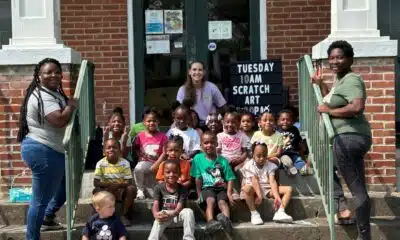
halbergman/E+ Collection via Getty Images
Robert Kane, Drexel University and Jordan Hyatt, Drexel University
Philadelphia’s plans to expand its use of police-operated drones signals a pivotal shift in how the city seeks to protect – and surveil – its citizens.
According to the city’s Citizen Police Oversight Commission, the Philadelphia Police Department had two drones as of early 2024. These were, the commission says, primarily used by SWAT teams to scout locations before serving high-risk warrants.
The 2025 city budget earmarks over US$800,000 for police drones, a spokesperson from the department’s Office of Public Affairs told us via email in response to our questions.
The spokesperson also confirmed that Philadelphia police are conducting test flights in Kensington and the surrounding area as part of the initial phase of a “Drone First Responder” program. For now, they say, they’re simply gathering data on how quickly drones respond to certain types of 911 calls compared with traditional police responses.
Police technology can evolve rapidly, and many police agencies across the country already use drones – including as first responders.
This technology may make the operation of law enforcement agencies more efficient and perhaps safer for officers, as they can have eyes on a scene from a safe distance. But many privacy advocates and members of the public have raised concerns about the privacy implications.
We are Philadelphia-based criminologists and researchers who seek to understand the impact of policing practices and technologies, including body-worn cameras and Tasers, on police legitimacy and public policy.
We see how drone policing can pose an almost entirely new set of potential benefits – and risks.

Andrew Caballero-Reynolds/AFP via Getty Images)
Benefits for police
Drones are already used for many commercial and recreational purposes.
In Pennsylvania, police drones have recently been used in traffic management and searches for fugitives.
These devices can be equipped with facial recognition, AI, gunfire detection and other new tech that has the potential to transform the scope and nature of the data that police can collect.
Drones can provide rapid emergency responses, such as locating missing persons in remote areas or delivering medical supplies to accident victims in hard-to-reach locations.
During critical situations, they can offer live intelligence by transmitting real-time aerial footage of active crime scenes, such as armed standoffs or large-scale public disturbances. This allows officers to effectively strategize without immediate exposure to danger.
Additionally, drones can reduce the risk of officer injuries during dangerous live pursuits by tracking fleeing suspects from the air, minimizing the need for high-speed vehicle chases or foot pursuits through hazardous environments.
Privacy concerns
Given their small size, aerial maneuverability and, in many cases, ability to record audio and video, drones present new and specific challenges to Fourth Amendment protections, particularly against unreasonable searches and seizures.
In the 1967 Katz v. United States case, the Supreme Court decided people are protected from being recorded by the police in places where they may reasonably expect privacy.
While that case was about a closed phone booth, the logic has been expanded over the years to protect people from new technological intrusion, such as thermal vision.
However, police do not need a warrant to observe and record activities that are visible to the public. In the 1988 case Florida v. Riley, for example, the court decided that police were permissibly able to look into someone’s yard from a helicopter hovering at 400 feet.
While drones are capable of flying much higher than 400 feet, they can also linger 40 feet, or even 4 feet, from a yard, building or window. And they do so in almost complete silence.
Though the Supreme Court has yet to decide whether it is reasonable for people to assume they are protected from drone-based imaging, the highest state court in Michigan recently allowed police to use warrantless drone-recorded footage to count the number of cars on a fenced property in pursuit of a civil zoning violation.
While each state is still able to set its own rules, privacy advocates are concerned that drone surveillance could be used to collect evidence without judicial oversight, or to surveil people without legal limitations or consequences for the violation of constitutional privacy rights.
Low-income communities and communities of color often bear the brunt of overpolicing and surveillance, and drone usage in these neighborhoods could exacerbate existing inequities by increasing scrutiny, perpetuating bias and reinforcing systemic distrust of policing.
Philadelphia’s track record concerning “stop-and-frisk” pedestrian stops sheds important light on those concerns.

Spencer Platt/Getty Images
Lessons from stop and frisk
The landmark stop-and-frisk case Bailey v. City of Philadelphia led to a federal consent decree over the Philadelphia Police Department’s stop-and-frisk practices.
This decree was called the “Bailey agreement.” It required the Philadelphia police to document all stop-and-frisk encounters, revise their policies and training to comply with constitutional standards, and reduce stops that lacked reasonable suspicion or were influenced by racial bias.
The agreement also established independent monitoring and public reporting to ensure transparency and accountability. Data analyses were regularly submitted to a federal judge for oversight.
The lessons from Bailey can inform how the Philadelphia Police Department might approach its drone program to avoid overreach. Misuse of these drones can directly affect the perceived legitimacy of police, already a fraught issue in some communities.
Here are several ways Philadelphia could avoid the pitfalls of unchecked surveillance when it comes to police drones.
1. Real-time monitoring
Real-time monitoring by an independent oversight body of drone deployments, along with clear documentation of each mission, would enable regular oversight like the structured checks in Bailey.
2. Transparency
Public reporting could help ensure community members understand the purposes and limitations of drone usage in their neighborhoods. An independent oversight body or a citizen review board could issue regular reports summarizing deployment data, such as the number of drone flights, their general locations and purposes, and the outcomes of those operations, along with details on data management and compliance with privacy safeguards.
Transparency around how data collected by police drones will be managed is essential for maintaining public trust. Data retention and deletion policies could reassure residents that drone data isn’t being stockpiled indefinitely but rather used only for its intended purpose.
3. Limited usage
Protocols can limit the scope of drone surveillance to specific, critical-use cases – such as emergencies or search-and-rescue operations – and avoid use for regular monitoring of public spaces. A narrowly defined scope would clarify that drones serve as targeted, situational tools rather than blanket surveillance devices.
4. Ethics training and education
Ethics training could be part of drone operator preparation to help pilots manage the gray areas of surveillance and ensure that deployments respect constitutional rights.
To further the culture of police accountability, drone operators and officers alike should understand that surveillance tools – whether stop-and-frisk or drones – have far-reaching implications for community relationships and the broader perception of justice.
5. Demonstrate effectiveness
Bailey’s monitoring process relied on metrics to evaluate stop-and-frisk practices, uncover patterns of misuse and guide reforms. Similarly, police might track the extent to which drones improve response times, reduce crime or enhance public safety in meaningful ways.
Such evaluations would require transparency in reporting results – and not just the successes but also the failures and unintended consequences. Without evidence-based assessments, public skepticism could prevail and undermine the technology’s legitimacy.
With clear guidelines, community involvement and legal accountability, we believe drones can enhance safety without compromising civil liberties, and foster rather than erode public trust.
Robert Kane, Professor of Criminology and Justice Studies, Drexel University and Jordan Hyatt, Associate Professor of Criminology and Justice Studies, Drexel University
This article is republished from The Conversation under a Creative Commons license. Read the original article.





















































